For our first trip to Sardinia, we decided to focus on the southwest region.
It came then naturally to include a two-days stay on San Pietro Island in our itinerary.
We organized the entire trip ourselves, from setting the dates and planning the itinerary to purchasing flight tickets, renting a car and find suitable accommodation for our needs.
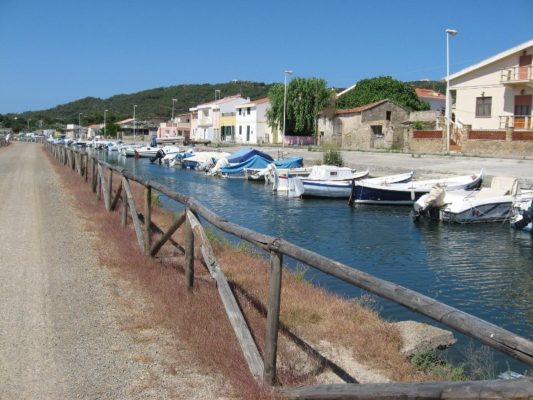
The salt route, Carloforte
San Pietro Island, along with Sant’Antioco, sits just a few miles south-west of the Sardinia coast.
The area is particularly suitable for family holydays with children and slow tourism enthusiasts who enjoy great food and outdoor activities.
Beyond the beautiful beaches and sea, there are plenty of opportunities for outdoor exploration, such as walking, trekking and biking.
If you’re wondering what to see in San Pietro Island, in this article we’ve put together a two-day itinerary (one full day and two half days).
Additionally, we’ve included practical tips and useful information to help you plan your visit.
Table of Contents
- How to get in San Pietro Island
- Where to Stay in Carloforte
- What to see in San Pietro Island
- Where and what to eat in Carloforte
How to get in San Pietro Island
In order to get to the San Pietro Island, we chose to take the ferries of the Delcomar Company following two different routes:
- Portovesme – Carloforte to reach the island;
- Carloforte – Calasetta (Sant’Antioco Island) on the way back.
To ensure that we had complete autonomy during our tour, we also rented a car.
We have been relying on DiscoverCars for many years.
It is an online price comparison service among various companies, easily accessible both from desktop and mobile devices.
For us, it is a guarantee.
The “free cancellation” option protects customers in case of last-minute unexpected events.
Where to stay in Carloforte
In Carloforte we highly recommend the family-managed Hotel Paola. It is located just two kilometers far from the city center.
It is a simple rustic property, overlooking the sea and surrounded in a beautiful natural scenery.
The hotel features rooms and a restaurant located on a scenic terrace, providing guests with an amazing view.
Here below you can check the best rates and availability:
What to see in San Pietro Island
Itinerary, day #1
Transfer to the San Pietro Island
At 1:30 PM we left Portovesme and after about 40 minutes of navigation, we docked on Carloforte pier, just in front of the statue of King Carlo Emanuele III di Savoia.
Our hotel was located a few kilometres far from the city center, in the village of Taccarossa.
The simple building is immersed inside a peaceful oasis of nature and relax.
After setting in, we visited La Punta, where the tonnara (tuna fishery) complex is located.
This tuna factory, with some buildings still under construction and others abandoned, offers a glimpse into the island’s tuna fishing history.
We arrived there in a few minutes, driving through an area of white houses with the properties bounded by dry stonewalls.
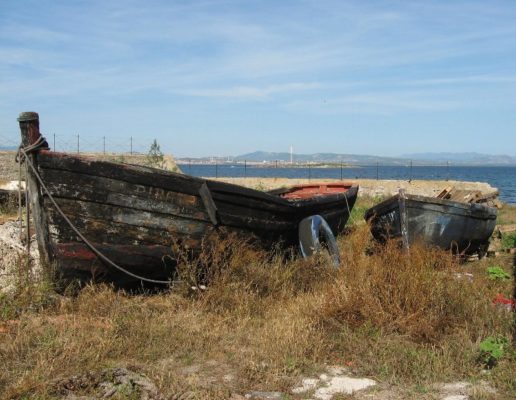
Courtyard adjacent to the old Tonnara
As we crossed the courtyard, we saw old wooden boats and untidy piles of nets stacked around us. Finally we reached the pier.
The fishermen were unloading the catch of the day, watched by the officers of the harbour master’s office.
The freshly caught big red tunas were transported to the processing and conservation buildings on an iron cart pulled by a tractor.
As we were watching the activity, we had the unexpected pleasure of meeting Marco, a fellow Friulian who lives only 15 kilometres away from our hometown.
He was there for work. He told us he was a manager of the company which buys most of the tuna caught in this tonnara.
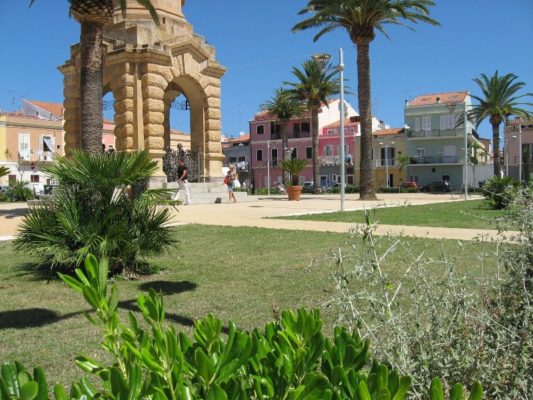
Carloforte, Pegli square
At sunset, we made our way back to Carloforte. We stopped a few minutes in Piazza Repubblica.
It has a square shape and, near its vertices, there are four large plants (three of them are definitely magnolias) around which iron benches have been placed in circle.
They were mainly occupied by old people. Interestingly, men only set with men and women with women.
Piazza Pegli was crowded too, even if people did not stop there due to the lack of shady spots.
Before calling it a day, I wrote down a few brief historical notes about the island.
In 1738, it was colonized by the inhabitants of Tabarka, a Tunisian island which was at that time a Ligurian colony owned by the Lomellini family, then lords of Pegli.
The reasons that pushed the tabarkini people to leave their island were mainly the coral reefs impoverishment and the limited extension of the island itself, which was no longer able to meet the needs of a population in continuous growth and protect them from pirate raids.
Known the intention of King Carlo Emanuele III° to repopulate Sardinia, they took the opportunity to leave Tabarka and settle here in San Pietro.
What to see in San Pietro Island
Itinerary, day #2
San Pietro Island
From the large windows of our hotel’s dining room, the view spans from the valley to the sea.
Just beneath us lies a beautiful garden filled with olive trees, lemons, cacti, oleanders and vibrant lilac bougainvilleas in full bloom.
In the distance, in backlight, we glimpsed a ferry shuttle that connects the island to Portovesme.
The placid sea reflected the sun’s ray and the hills surrounding the Sulcis coast on us.
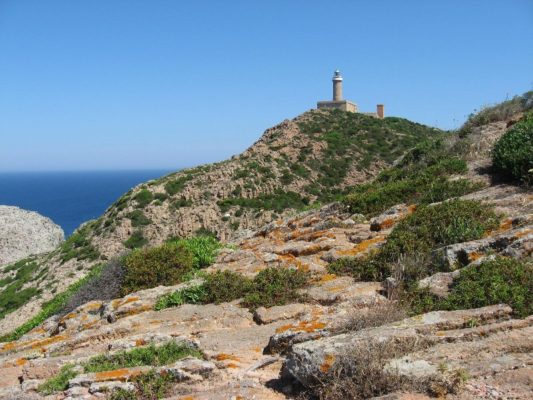
Lighthouse and belvedere of Capo Sandalo
In the morning, we planned the trip to Capo Sandalo.
Just outside the village of Carloforte, we took the road that cuts the island horizontally in two parts and after about ten kilometres, we arrived at the lighthouse.
We parked the car on a clear space and from there we walked on a nice paved path towards the lookout point.
There were very few people at that time and this allowed us to sit on the rocks and escape from everything.
All we could hear were the wind gusts and the seagulls’ cries, seeking refuge on the cliffs below us.
Close by, there is a colony of queen hawks.
These are certainly the windiest areas on the island and consequently the vegetation is affected: there are just Mediterranean species, such as cistus, rosemary, cactus and euphorbia.
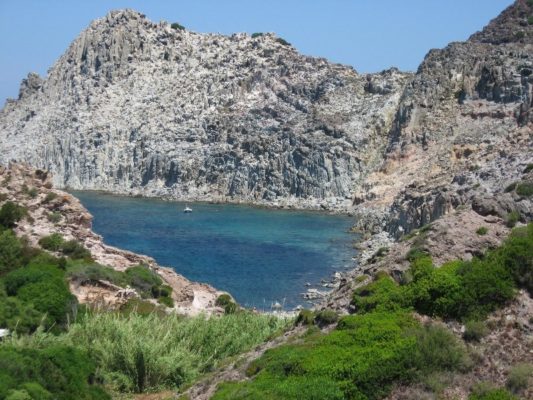
Cala Fico beach
Following a different path, we were able to easily make our way down to the sea.
Heading back to Carloforte we made a stop at Cala Fico beach and then visited the old saltpans, where we were delighted to spot some pink flamingos.
In the meanwhile, the sirocco wind was blowing hard, but the sailors predicted that it would turn in mistral the following day.
We spent part of the afternoon in one of the most stunning beaches on the south coast, La Bobba.
From the parking lot in front of the beach, a paved path starts which in a ten-minute walk leads to Le Colonne, two stacks surrounded by white foam produced by the crashing waves.
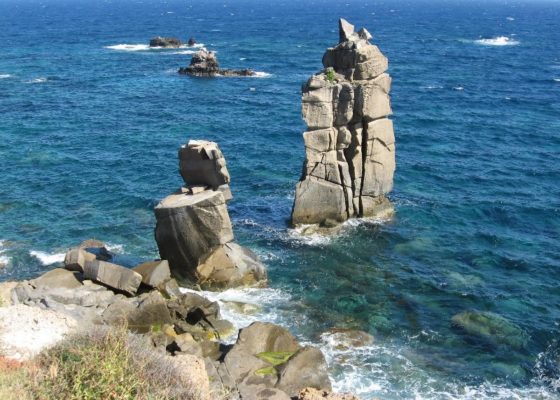
Columns of Carloforte
Carloforte is a town that is meticulously maintained, with a picturesque seafront adorned with palm trees and colorful bougainvilleas.
Its attractions are not limited to the historic center alone but extend to the suburbs, which can be conveniently explored by taking leisurely strolls.
The buildings are characterized by pastel-colored facades, wooden window shutters, wooden doors on the balconies called Galaie.
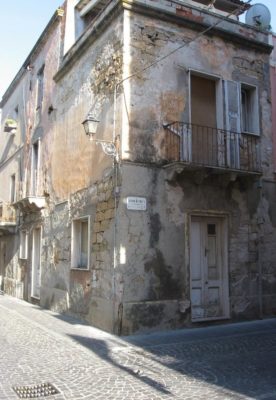
Houses in Carloforte
Steep narrow alleys lead from the waterfront to the ancient village.
Preparing for religious festivities, the Church of San Carlo stood ready to welcome devout worshippers.
What to see in San Pietro Island
Itinerary, day #3
San Pietro Island and transfer to Teulada
We woke up to a refreshing mistral breeze blowing into our room, confirming the sailors’ forecast.
Our accommodation was a family-run business situated in a picturesque location, and one of the owners informed us that they operate from May to October thanks to tourism, while during the off-season they focus on maintaining the garden and infrastructure.
Despite the wind being bothersome, it had the benefit of spreading the fragrance of the Mediterranean scrub, while the birds’ chirping created relaxing melodies.
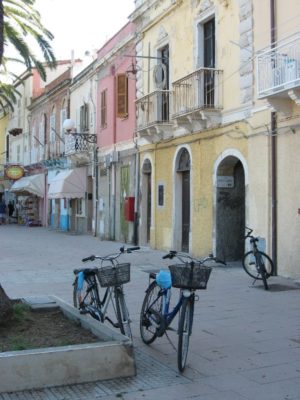
The seafront of Carloforte
Our two-day itinerary to discover the things to see in the San Pietro Island ended here.
If you have a few more days, you can explore the area following other hiking trails or you can enjoy your holiday in complete relaxation on the beautiful beaches.
The ferry slowly moved away from Carloforte, the palm trees that lined the seafront gradually shrank in size, while the Ratti Island and the Piana Island slided alongside us.
Although the sea was rough, navigation was not affected that much.
In the early afternoon we arrived in Teulada and begun to discover the landscape and the beautiful beaches located on the southern coast of Sardinia.
What to eat in Carloforte
During our tour on the San Pietro Island we relied on packed meals for half-day snacks, while in Carloforte we had dinner in two restaurants that even after many years we still feel to recommend:
- Ristorante 1° Maggio, the restaurant is located in our Hotel, with excellent dishes of the typical cuisine of Carloforte;
- Ristorante da Andrea, also called Osteria alla Tonnara, located at the southern end of the marina.
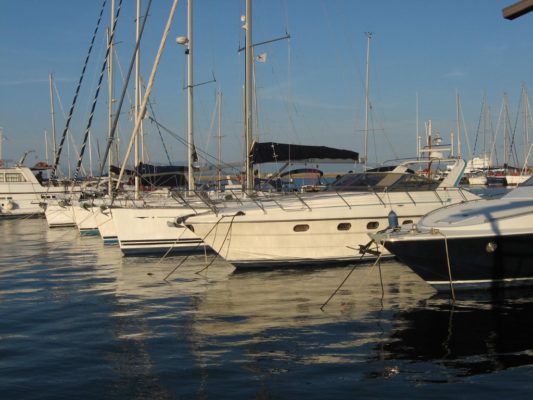
Boats moored in the marina of Carloforte
You cannot leave the island before having tasted the typical local dish, a delicious roasted carlofortina tuna.
Here is the recipe:
Ingredients:
400 gr. fresh tuna (preferably from Carloforte) cut into medium slices, extra virgin olive oil, 3 peeled garlic cloves, half a glass of white wine, 3 tablespoons of tomato sauce, 5 bay leaves, white vinegar, 1 tablespoon of flour, salt.
Preparation:
Wash the tuna and dry it well. Fry in a large pan (lightly floured) in plenty of oil until it turns golden brown.
In a separate pan, place the fried tuna in a little oil in which you will have the crushed garlic cloves golden.
Let the tuna flavour and add half a glass of white wine and allow it to consume for a few minutes. Add the sauce, some bay leaves and a few tablespoons of white vinegar.
Allow evaporating and leave to absorb everything in the cooking sauce with a half-closed lid.

0 Comments